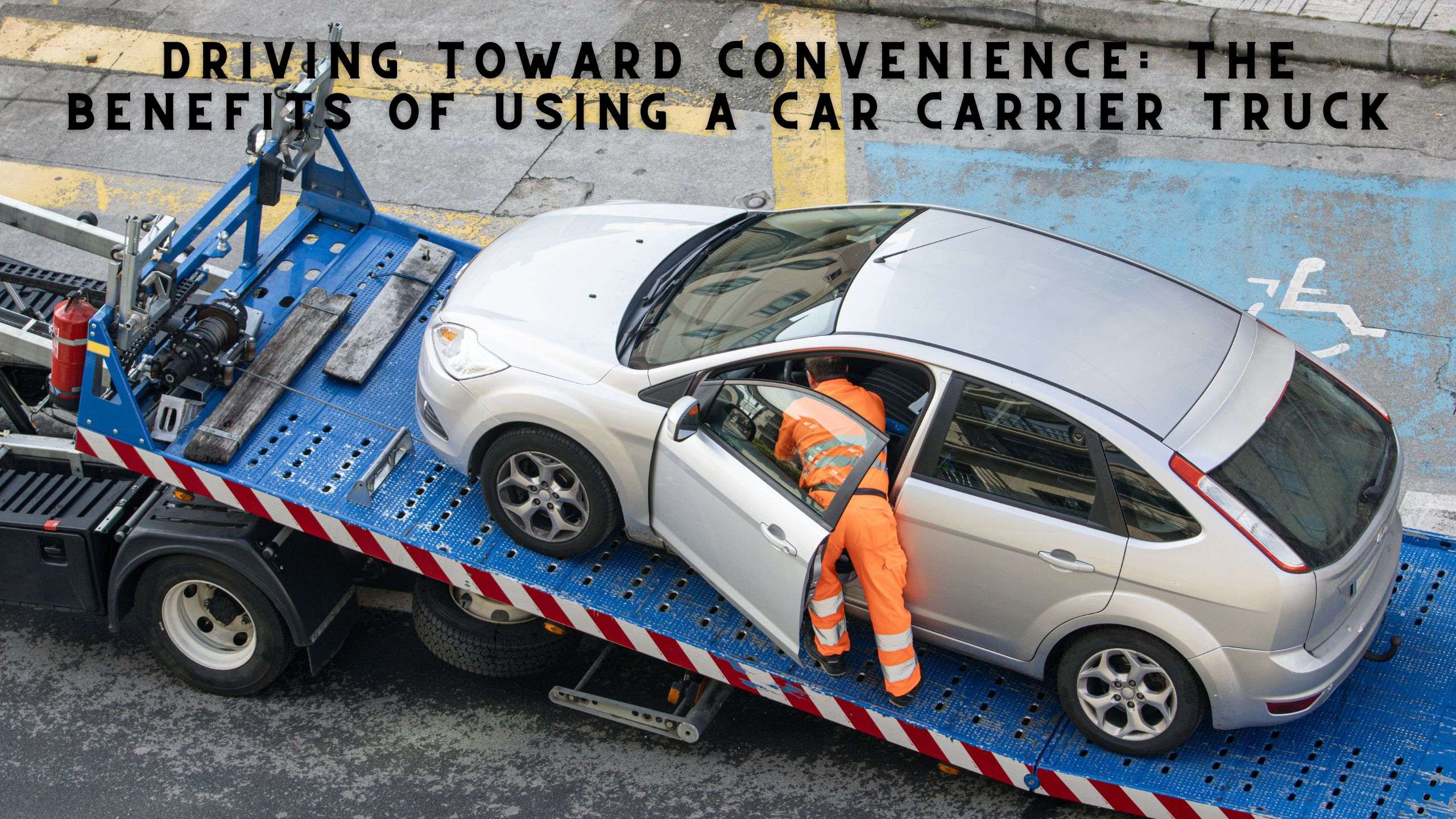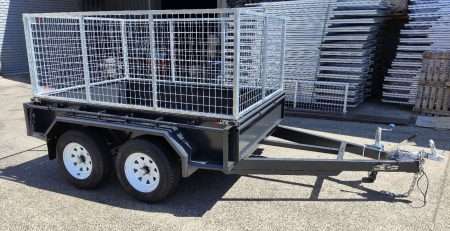
Driving Toward Convenience: The Benefits of Using a Car Carrier Truck
Understanding Carrier Trucks
Car carrier trucks, also known as auto transporters or car hauliers, play a crucial role in the transportation of multiple vehicles at once. These specialised trucks are designed to securely and efficiently transport cars from one location to another. Understanding the basics of car carrier trucks is essential for anyone involved in the automotive industry or in need of vehicle transportation services.
What are car carrier trucks?
Car carrier trucks are specifically designed to transport multiple vehicles at once, making them an essential tool for the automotive industry (Transwest). These trucks are equipped with specialised trailers that can securely hold and transport cars from one place to another. Car carrier trucks come in various sizes and configurations, allowing for different capabilities and accommodating various vehicle types.
Car carrier trucks are capable of carrying anywhere from 3 to 12 vehicles, depending on the size and configuration of the truck (Transwest). The trailers used by car carrier trucks have multiple levels or decks where cars can be loaded and secured for transportation. This efficient design maximises the number of vehicles that can be transported on a single trip.
Types of Car Carrier Trucks
Car carrier trucks come in various types to meet different transportation needs. The choice of car carrier truck depends on factors such as the type of vehicles being transported, the distance of transportation, and the level of protection required. Here are some common types of car carrier trucks:
- Open-Air Car Carriers: These carriers have open trailers that expose the vehicles to the elements during transportation. They are commonly used for short-distance or local transportation, where weather conditions are not a significant concern. Open-air car carriers are cost-effective and can transport a large number of vehicles.
- Enclosed Car Carriers: Enclosed car carriers feature trailers with walls and a roof, providing protection from external elements such as weather, dust, and road debris. These carriers are often preferred for long-distance transportation or when transporting high-value or classic vehicles that require extra care and security.
- Flatbed Car Carriers: Flatbed car carriers have a flat trailer bed without any sides or roof. They are commonly used for transporting oversized vehicles, construction equipment, or vehicles with non-standard dimensions. Flatbed carriers provide versatility in loading and securing different types of vehicles.
By understanding the different types of car carrier trucks available, individuals and businesses can choose the most suitable option for their specific transportation needs. Whether it’s open-air, enclosed, or flatbed carriers, car carrier trucks provide a convenient and efficient solution for transporting multiple vehicles at once.
Capacity of Car Carrier Trucks
When it comes to transporting vehicles, car carrier trucks play a vital role. These trucks are specifically designed to transport multiple vehicles simultaneously, making them an efficient and convenient choice for car transportation. Let’s explore the factors that affect the capacity of car carrier trucks and the number of vehicles they can transport.
Factors Affecting Capacity
The capacity of car carrier trucks can vary depending on several factors. These factors include the size and configuration of the truck, as well as any legal weight restrictions. Car carrier trucks typically have a capacity to carry anywhere from 3 to 12 vehicles (Transwest). The specific capacity of a truck will depend on its design and specifications.
Under U.S. law, car carrier trailers are limited by an 80,000-pound weight cap, which affects their capacity. This weight cap determines the number of vehicles that can be transported while ensuring compliance with legal regulations (Wikipedia). It’s crucial for car carrier truck operators to adhere to these weight restrictions to ensure safe and legal transportation.
Number of Vehicles That Can Be Transported
Car carrier trucks are designed to transport multiple vehicles at once, allowing for efficient transportation and cost-effectiveness. The number of vehicles that can be transported on a single trip depends on various factors, such as the size and weight of the vehicles as well as the specific design of the truck.
On average, car carrier trucks can transport anywhere from 5 to 12 vehicles per trip (AutoTransport.com). The exact number will depend on the size and configuration of the truck, as well as any weight restrictions imposed by regulations.
It’s important to note that car carrier trucks can transport a wide range of vehicles, including cars, trucks, SUVs, and motorcycles. These trucks are versatile and can accommodate both small and large vehicles, making them suitable for various transportation needs (Montway).
Understanding the capacity of car carrier trucks is essential when planning to transport vehicles. By considering factors such as the truck’s design, weight restrictions, and the size of the vehicles being transported, you can ensure that the transportation process is efficient and meets your specific requirements.
Features of Car Carrier Trucks
Car carrier trucks are specifically designed to transport vehicles efficiently and safely. These trucks are equipped with various features that facilitate the loading, securing, and transportation of vehicles. Two key features of car carrier trucks are hydraulic ramps and lift systems and tie-down systems for securing vehicles.
Hydraulic Ramps and Lift Systems
Car carrier trucks are often equipped with hydraulic ramps or lift systems to load and unload vehicles efficiently and safely. These systems allow for easy adjustment of the truck’s bed height, ensuring seamless alignment with the ground or loading dock.
By utilising hydraulic power, the ramps or lift systems can be raised or lowered, eliminating the need for manual labour and reducing the risk of injuries during the loading and unloading process. This feature is particularly beneficial when transporting vehicles with low ground clearance, as it provides a gentle incline for easy access onto the truck bed.
Tie-Down Systems and Securing Vehicles
To ensure the safe transportation of vehicles, car carrier trucks are equipped with tie-down systems for securing the vehicles in place (RoadRunner Auto Transport). Cars are typically secured to the carrier using tiedown straps in four different places, usually the four wheels and/or corresponding parts of the chassis. This ensures that the cars remain stable and do not move around, minimising the risk of damage during transit.
Securing vehicles properly is essential to prevent shifting or damage during transport. The tie-down systems on car carrier trucks are designed to withstand various road conditions, keeping the vehicles secure throughout the journey. By securing the vehicles at multiple points, the risk of any significant movement or damage is greatly reduced.
Car carrier trucks often have specialised features, such as winches and adjustable decks, to further facilitate the loading and unloading process (Transwest). These additional features help to ensure that the vehicles are safely and securely positioned on the truck bed, allowing for efficient and safe transportation.
With the help of hydraulic ramps and lift systems, as well as tie-down systems, car carrier trucks provide a reliable and secure means of transporting vehicles. These features contribute to the overall efficiency and safety of the loading, securing, and transportation processes.
Car Carrier Truck Usage
Car carrier trucks play a vital role in the automotive industry and are also commonly used for personal vehicle transport. Let’s explore the various applications of car carrier trucks.
Automotive Industry Applications
Car carrier trucks are extensively utilised in the automotive industry for transporting new vehicles from manufacturers to dealerships. This transportation process ensures that newly manufactured cars reach their intended destinations safely and efficiently. Car dealerships rely on the services of car carrier trucks to receive their inventory of new vehicles, allowing them to offer a wide range of options to their customers.
Additionally, car carrier trucks are instrumental in the movement of used vehicles within the automotive industry. They transport vehicles between locations for car dealerships, rental companies, and transportation businesses. Car carrier trucks facilitate the delivery of new vehicles to dealerships and the transportation of used vehicles to auctions or rental lots. This enables the automotive industry to efficiently manage their inventory and meet the demands of their customers.
Personal Vehicle Transport
In addition to their use in the automotive industry, car carrier trucks are also employed for personal vehicle transport. Individuals who are relocating or selling their vehicles often rely on car carrier trucks to transport their cars over long distances. This service provides a convenient and secure method for moving vehicles without the need for excessive driving or wear and tear on the vehicle.
Whether it’s a cross-country move or the sale of a vehicle to a buyer in another location, car carrier trucks offer a reliable solution for transporting personal vehicles. They ensure that vehicles are delivered to their destination safely and without incurring additional mileage or potential damage from road travel.
By utilising car carrier trucks, both the automotive industry and individuals can benefit from the convenience, efficiency, and reliability of transporting vehicles in bulk or individually to meet their specific needs.
To learn more about car carrier trucks and the services they provide, you can explore options such as car carrier rental, car carrier transport, and car carrier shipping. Whether you’re in need of personal vehicle transport or require car carrier services for your automotive business, there are various options available to suit your requirements.
Safety Considerations for Loading and Unloading
Loading and unloading vehicles, including car carrier trucks, is a task that requires careful attention to safety. Failure to adhere to proper safety practices can result in workplace injuries and accidents. Understanding the hazards and implementing best practices is crucial to ensuring the safety of personnel and the protection of the vehicles being transported.
Hazards and Risks
Loading and unloading motor vehicles, including those on car carrier trucks, can pose various hazards and risks. Some of the common workplace injuries associated with vehicle loading and unloading include:
- Forklift accidents: Forklifts are often used in the loading and unloading process, and accidents involving forklifts can result in serious injuries. It is important to ensure that forklift operators are properly trained and follow safe operating procedures to minimise the risk of accidents.
- Injuries from falling materials: During the loading and unloading process, there is a risk of objects or cargo falling from the vehicle, potentially causing injuries to workers. Proper securing of the cargo and the use of appropriate equipment, such as harnesses and safety netts, can help mitigate this risk.
To prevent accidents and injuries during the loading and unloading process, it is important to follow best practices and adhere to safety guidelines.
Best Practices for Safe Loading and Unloading
To ensure the safe loading and unloading of vehicles, including those on car carrier trucks, the following best practices should be followed:
- Proper training: All personnel involved in the loading and unloading process should receive appropriate training on safe work practices, including the use of equipment and machinery.
- Clear communication: Effective communication between the driver, the loading and unloading personnel, and any other involved parties is essential to ensuring a smooth and safe process. This includes clear instructions, signals, and an understanding of roles and responsibilities.
- Stable and well-lit loading areas: Loading areas should be properly maintained, well-lit, and free from hazards such as potholes and debris. This helps to prevent slips, trips, and falls.
- Appropriate personal protective equipment (PPE): Workers involved in the loading and unloading process should wear appropriate PPE, such as hard hats, high-visibility clothing, gloves, and safety footwear, to protect themselves from potential hazards.
- Safe lifting techniques: Proper lifting techniques should be employed when handling heavy or awkwardly shaped objects. This includes bending the knees, keeping the back straight, and using mechanical aids like forklifts or trolleys when necessary.
- Secure and stable loading: cargo should be properly secured to prevent shifting during transportation. This can include the use of tie-down straps, chains, or other securing mechanisms. Proper weight distribution within the vehicle is also important to maintain stability during transit.
By implementing these best practices, the risks and hazards associated with loading and unloading vehicles on car carrier trucks can be minimised, ensuring the safety of workers and the protection of the vehicles being transported.
Remember to always prioritise safety and follow relevant guidelines and regulations. If you’re interested in learning more about car carrier trucks and related services, check out our article on car carrier companies.
Different Types of Auto Carriers
When it comes to transporting vehicles, there are different types of auto carriers available to suit various needs. Each type of carrier offers its own advantages and considerations. In this section, we will explore three common types of auto carriers: open-air car carriers, enclosed car carriers, and flatbed car carriers.
Open-Air Car Carriers
Open-air car carriers are the most common type of auto carrier. These carriers feature an open design, allowing vehicles to be transported on multiple levels. Typically, open-air car carriers have a maximum capacity of 9 to 12 cars (RoadRunner Auto Transport). They are often the most affordable option for shipping a car compared to other carrier types.
While open-air car carriers provide efficient and cost-effective transportation, it’s important to note that vehicles are exposed to the outdoor elements during transit. Factors such as tree branches, UV rays, rain or hail, and small rocks may affect the condition of the vehicle. However, reputable car carrier companies take the necessary precautions to minimise any potential damage.
Enclosed car carriers
For those seeking maximum protection for their vehicles during transportation, enclosed car carriers are an excellent choice. These carriers provide a fully enclosed environment, shielding vehicles from outdoor elements such as tree branches, UV rays, rain or hail, and small rocks. Enclosed car carriers typically have a capacity ranging from 2 to 10 vehicles during shipments (RoadRunner Auto Transport).
The added protection of enclosed car carriers makes them ideal for transporting high-value or classic vehicles that require extra care. The enclosed environment helps to maintain the vehicle’s condition and appearance throughout the journey. However, it’s important to note that enclosed car carrier services may be more expensive compared to open-air carriers due to the added protection and specialised handling.
Flatbed Car Carriers
Flatbed car carriers are primarily used for shipping oversized vehicles such as Humvees, buses, recreational vehicles, commercial trucks, tractors, and boats. These carriers feature a flat, open trailer bed with no sides or roof. Flatbed car carriers typically have a maximum capacity of one or two vehicles, but they can also carry 4 to 8 motorcycles at a time (RoadRunner Auto Transport).
The open design of flatbed carriers allows for easy loading and unloading of vehicles, making them a popular choice for unconventional or specialised vehicles. It’s important to ensure that the vehicle is securely fastened to the flatbed to prevent any movement or damage during transit. Flatbed car carriers offer flexibility and convenience for shipping vehicles that don’t fit within the standard dimensions of enclosed or open-air carriers.
By understanding the different types of auto carriers available, you can choose the one that aligns with your specific transportation needs. Whether you opt for the affordability of an open-air car carrier, the added protection of an enclosed car carrier, or the flexibility of a flatbed car carrier, it’s essential to work with a reliable car carrier company that prioritises the safety and care of your vehicle.
Cost Considerations for Carrier Services
When it comes to car carrier services, understanding the factors that affect shipping costs and comparing prices for different carrier types is essential. Whether you’re looking to transport your vehicle locally or across long distances, being aware of these cost considerations can help you make an informed decision.
Factors Affecting Shipping Costs
The cost of shipping a car on a carrier truck can vary based on several factors. Here are some key considerations that can influence the overall shipping costs:
- Carrier Type: The type of car carrier you choose plays a significant role in determining the shipping costs. The most common types include open-air car carriers, enclosed car carriers, and flatbed car carriers. According to RoadRunner Auto Transport, open-air carriers are typically the cheapest option, while enclosed carriers can cost an additional $400 to $700. Flatbed carrier costs vary depending on factors such as distance, fuel prices, and vehicle type.
- Distance: The distance your vehicle needs to travel is another crucial factor in determining the shipping costs. Longer distances generally result in higher shipping costs, as they require more time, fuel, and resources.
- Vehicle Type: The size, weight, and dimensions of your vehicle can impact the shipping costs. Larger or heavier vehicles may require specialised carriers, which can be more expensive to transport.
- Time of Year: Seasonal fluctuations in demand can affect shipping costs. Busier times, such as peak moving seasons, holidays, or extreme weather conditions, may result in higher prices due to increased demand and limited carrier availability.
- Fuel Prices: Fluctuations in fuel prices can contribute to changes in shipping costs. Higher fuel prices can lead to increased shipping rates.
- Notice Given: Providing advanced notice for your shipment can potentially result in more competitive pricing. Last-minute requests may incur additional charges due to the need for expedited services.
Pricing Comparison for Different Carrier Types
To help you understand the cost differences between various carrier types, here’s a general pricing comparison based on information from RoadRunner Auto Transport:
| Carrier Type | Price Range |
|---|---|
| Open-Air Car Carriers | The cheapest option compared to other carriers |
| Enclosed car carriers | Additional $400 to $700 compared to open-air carriers |
| Flatbed Car Carriers | Costs vary based on distance, fuel prices, and vehicle type. |
It’s important to note that these pricing ranges are approximate and may vary depending on additional factors specific to your shipment. To get an accurate quote for your car carrier needs, it’s recommended to reach out to reputable car carrier companies or use online car carrier services that provide cost estimates based on your specific requirements.
By considering the factors that affect shipping costs and comparing prices for different carrier types, you can make an informed decision when choosing a car carrier service that aligns with your budget and transportation needs.
Author
I am Rahatul Ashiq Tamal. Another author of Muscle Trailers. Muscle Trailers is a well-known trailer brand in Sydney, Melbourne & Adelaide

How to Mount a Spare Tire on Your Trailer: A Simple Step-by-Step Guide
Trailer service centers receive over 1 million phone calls and 1.3 million emails each year about trailer maintenance problems....

How to Fix RV Roof Leaks: Simple Roof Leak Detection Guide for Beginners
Did you know DIY RV roof repairs can cost under $50? But undetected leaks could lead to substantially higher repair...

Starting a Food Truck Business in Australia: From Trailer Selection to Launch
The Australian mobile food market has evolved into a billion-dollar industry. This makes a food truck...
